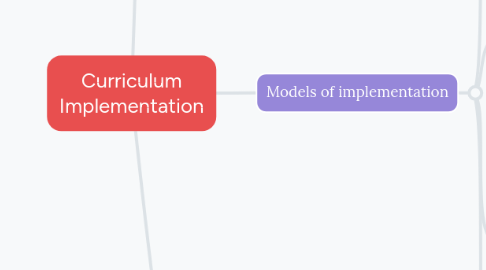
1. The interaction between the curriculum that has been written and planned and the persons (teachers) who are engaged in charged to deliver it.
1.1. Shift from what is the current to a new.
1.2. Change in knowledge, actions, and attitudes of the persons involved.
1.3. Change in behavior
2. Role of Stakeholders
2.1. Stakeholders
2.1.1. They are the one who put into action and give life to the curriculum.
2.2. Learners
2.2.1. They are the very reason a curriculum is developed.
2.3. Teachers
2.3.1. A teacher is a curriculum maker/ curricularist.
2.4. Curriculum managers and Administrators
2.4.1. responsible to the kind of curriculum their school will offer and how these are implemented.
2.5. Parents
2.5.1. The best supporters of the curriculum.
2.6. Community members
2.6.1. Curriculum resources
2.7. Government
2.7.1. DEPED, CHED and TESDA
2.8. Professional organizations
2.8.1. contribute in curriculum review
2.9. Professional Regulation Commission
3. Models of implementation
3.1. ORC model
3.1.1. Overcoming Resistance to Change
3.1.1.1. rests on the assumption that the success of curriculum implementation primarily depends on the impact the developer can make on the consumers.
3.1.2. Developmental stage
3.1.2.1. Unrelated Concerns
3.1.2.1.1. teachers do not perceive a relationship between themselves and the suggested changes.
3.1.2.2. Personal Concerns
3.1.2.2.1. the teacher will react to the innovation in relation to his/her personal situation.
3.1.2.3. Task-related Concerns
3.1.2.3.1. relates to the actual use of the innovation.
3.1.2.4. Impact-related Concerns
3.1.2.4.1. The teacher will be concerned with how the innovation will influence others.
3.2. LOC model
3.2.1. Leadership-Obstacle Course model.
3.2.1.1. treats staff resistance to change as problematic and proposes that we should collect data to determine the extent and nature of the resistance.
3.2.1.2. 3 stages
3.2.1.2.1. Initiation
3.2.1.2.2. Attempted implementation
3.2.1.2.3. Incorporation
3.3. Linkage model
3.3.1. Linkage model
3.3.1.1. Recognizes that there are innovators in research and development centers, universities, etc.
3.3.1.2. What is needed is a match between the problems and innovations-the establishment of linkages.
3.3.1.3. 2 Systems
3.3.1.3.1. User system
3.4. RCA model
3.4.1. Rand Change Agent model
3.4.1.1. suggests that organizational dynamics seem to be the chief barriers to change.
3.4.1.2. 3 Stages
3.4.1.2.1. Initiation
3.4.1.2.2. Implementation
3.4.1.2.3. Incorporation
3.4.1.3. Resource system
3.4.1.3.1. should have a clear picture of the curriculum user' problems, either to retrieve or create appropriate educational packages.
